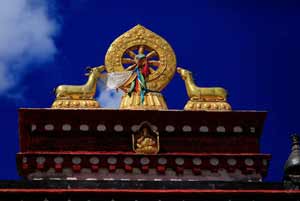Sera Monastery is one of the 'great three' Gelug university monasteries of Tibet, located 1.25 miles (2.01 km) north of Lhasa and about 5 km (3.1 mi) north of the Jokhang. The other two are Ganden Monastery and Drepung Monastery. The origin of its name is attributed to a fact that the site where the monastery was built was surrounded by wild roses in bloom.
The original Sera Monastery is responsible for some 19 hermitages, including four nunneries, which are all located in the foot hills north of Lhasa.
The Sera Monastery, as a complex of structures with the Great Assembly Hall and three colleges, was founded in 1419 by Jamchen Chojey of Sakya Yeshe of Zel Gungtang (1355¨C1435), a disciple of Je Tsongkhapa.
During the 1959 revolt in Lhasa, Sera monastery suffered severe damage, with its colleges destroyed and hundreds of monks killed. After the Dalai Lama took asylum in India, many of the monks of Sera who survived the attack moved to Bylakuppe in Mysore, India. After initial tribulations, they established a parallel Sera Monastery with Sera Me and Sera Je colleges and a Great Assembly Hall on similar lines to the original monastery, with help from the Government of India. There are now 3000 or more monks living in Sera, India and this community has also spread its missionary activities to several countries by establishing Dharma centres, propagating knowledge of Buddhism.
Sera Monastery in Tibet and its counterpart in Mysore, India are noted for their debate sessions.
The original Sera Monastery is a complex of structures founded in 1419 by Jamchen Chojey Sakya Yeshe of Zel Gungtang (1355¨C1435), a disciple of Je Tsongkhapa. Prior to establishing this monastery, Tsongkhapa, assisted by his disciples, had set up hermitages at higher elevations above Sera Uts¨¦ Hermitage.
The Sera complex is divided into two sectors by pathways; the eastern part contains the Great Assembly Hall and the dwellings and the western part has the well-known three colleges: the Sera Je Dratsang, the Sera Me Dratsang; and the Ngakpa Dratsang, all instituted by Tsongkhapa as monastic universities that catered to monks in the age range 8-70. All the structures within this complex formed a clockwise pilgrimage circuit, starting with the colleges (in the order stated), followed by the hall, the dwelling units and finally ending at the hermitage of Tsongkhapa above the Great Assembly Hall.
Over the years, the monastery developed into a hermitage where about 6000 monks resided. The monastery was one of the finest locations in Tibet to witness the debate sessions, which were held according to a fixed schedule.[9] The monastery belongs to the Gelug Order and was one of the largest in Lhasa. In 2008, Sera had 550 monks in residence.
|
|



 |



